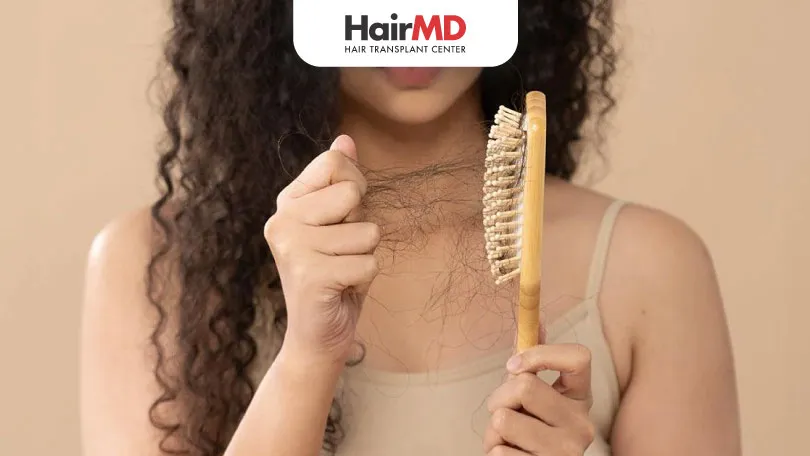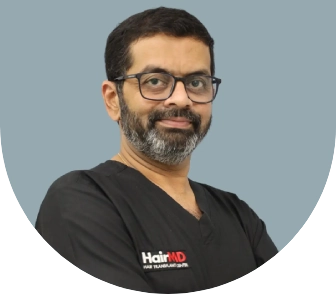
Hair shedding is something many people worry about, raising concerns about the health of their hair. It’s natural to wonder if the amount of hair you’re losing is normal or a sign of something more serious.
In this guide, we’ll explore the difference between regular hair loss and excessive shedding, helping you understand what’s normal and when it’s time to consult a specialist. By the end, you’ll have a clearer picture of hair shedding and how to take care of your hair health. Let’s dive in to uncover the facts!
What’s covered in the article?
- What is Hair Shedding?
- The Hair Growth Cycle
- Normal vs. Excessive Hair Shedding
- Causes of Excessive Hair Shedding
- Taking Action Against Excessive Hair Shedding
- Conclusion
What is Hair Shedding?
Hair shedding is a natural process and an integral part of the hair’s lifecycle, which includes growth, rest, and shedding phases. On any given day, it’s normal to lose between 50 to 100 hairs, a fact that should bring relief to those who fear the sight of hair on their brush or shower drain. This natural shedding is the scalp’s way of making room for new growth and maintaining healthy hair density.
Excessive Hair Shedding: Main Causes & How to control it? | Dr Manali Shah, HairMD Pune
The Hair Growth Cycle
The hair growth cycle is a fascinating process that unfolds in three distinct stages, each playing a crucial role in maintaining the health and density of our hair. This cycle ensures that hair follicles are continuously regenerated, allowing for hair loss and growth to balance each other out.
In the Anagen phase, which is the growth phase, hair follicles are in their most active state. During this period, hair strands grow from the follicles at a steady rate, which can last anywhere from two to six years. The length of hair, its strength, and overall health are significantly determined during this phase.
Following the Anagen phase is the Catagen phase, a transitional stage that marks the end of active growth. Lasting about two to three weeks, this phase is when the hair follicle shrinks and detaches from the dermal papilla, a structure critical to hair growth. This process prepares the hair for its eventual shedding, making way for new growth.
The final stage is the Telogen phase, known as the resting phase. During this time, which can last around three months, the hair doesn’t grow but remains attached to the follicle.
Eventually, these hairs are shed, often during brushing or washing, and the cycle begins anew with the Anagen phase. This natural shedding is a vital part of the hair renewal process, making room for fresh growth and maintaining the normal hair density.
Part 2: Revealing Relation Of Hair Loss And Hair Growth Cycle | HairMD, Pune | (In HINDI)
Normal vs. Excessive Hair Shedding
Hair goes through a natural cycle that includes growth, rest, and shedding. Losing 50 to 100 hairs daily is normal and part of the hair’s lifecycle, ensuring new growth and maintaining overall hair health. This shedding is the scalp’s way of rejuvenating and should not alarm you.
The hair growth cycle comprises three phases: the Anagen or growth phase, Catagen or transition phase, and Telogen or resting phase. The telogen phase culminates in the natural shedding of hair, allowing new strands to emerge. This cycle underscores the constant renewal process our scalp undergoes, emphasizing that daily hair loss within a certain range is perfectly normal.
However, when hair loss becomes more pronounced, it may signal excessive shedding. Signs of this include losing more than the usual number of strands, noticeable thinning, or bald patches. Factors contributing to excessive shedding range from physical and emotional stress, nutritional deficiencies, hormonal imbalances, to certain medical conditions and treatments.
Stress can temporarily increase hair shedding, while poor nutrition lacking in essential proteins and vitamins weakens hair. Hormonal changes during events like pregnancy, menopause, or due to conditions such as PCOS and thyroid issues, significantly affect hair health. Additionally, certain medications, over-styling, and genetic predispositions can exacerbate hair loss.
Addressing excessive hair shedding involves recognizing these signs early and understanding their potential causes. If you observe any concerning symptoms, seeking advice from a dermatologist or hair care specialist is crucial. They can provide tailored treatment options based on the underlying cause.
Simple lifestyle adjustments, such as improving your diet, reducing stress, or modifying your hair care routine, can often help manage hair loss. In other cases, more specific medical interventions may be necessary.
It’s important to remember that timely action can significantly impact managing and treating hair loss. Ignoring the signs of excessive shedding and delaying consultation can lead to prolonged and possibly irreversible hair health issues. Being proactive about hair care, maintaining a balanced diet, minimizing stress, and avoiding harsh hair treatments can all contribute to healthier hair.
In short, excessive shedding can be identified by several signs, including:
- Losing more than 100 hairs a day.
- Noticing more hair fall than usual during brushing or showering.
- Seeing bald patches or increased scalp visibility.
- Experiencing more tangling, thinning, or a noticeable decrease in hair volume.
If you’re facing any of these symptoms, it’s a signal that your hair shedding might not be normal.
Causes of Excessive Hair Shedding
Excessive hair shedding can be attributed to various factors, ranging from stress and nutritional deficiencies to hormonal changes and medical conditions.
Here’s the list of primary causes:
Stress: Both physical and emotional stress play a significant role in hair health. They can trigger a temporary increase in hair shedding by disrupting the normal growth cycle of hair follicles.
Nutritional Deficiencies: A diet lacking essential nutrients, proteins, and vitamins can lead to weakened hair strands. Proteins and vitamins are vital for maintaining strong and healthy hair, and their absence can exacerbate hair loss.
Hormonal Changes: Shifts in hormone levels, such as those experienced during pregnancy, menopause, or due to conditions like Polycystic Ovary Syndrome (PCOS) and thyroid imbalances, have a profound impact on hair growth and shedding. These hormonal changes can either stimulate hair growth or cause significant shedding.
Medical Conditions: Certain health issues can lead to excessive hair shedding. Diseases that affect the immune system, scalp conditions like dermatitis, and infections can all disrupt the natural hair growth cycle.
Medications: Some medicines can cause hair loss as a side effect. This includes drugs for blood pressure, chemotherapy treatments for cancer, and other medications that may affect the hair’s growth and shedding phases.
Over-styling and Heat Damage: Frequent use of heat styling tools, chemical treatments, and harsh hair styling practices can damage hair follicles, leading to increased shedding. Over-styling physically stresses the hair strands and can weaken them over time, making them more prone to falling out.
Genetic Predisposition: Genetics play a crucial role in determining hair density, growth rate, and the likelihood of experiencing hair loss. If there is a history of hair loss in the family, you may be more susceptible to experiencing excessive shedding.
Taking Action Against Excessive Hair Shedding
Addressing excessive hair shedding starts with recognizing the signs and understanding their causes. Once identified, it’s imperative to consult a dermatologist or a hair care specialist who can offer tailored advice and treatment options.
In some cases, adjusting your diet, reducing stress, or changing hair care routines can mitigate hair loss. For others, medical interventions might be necessary.
DO YOU KNOW?
Nearly 250 Patients Visit HairMD
Everyday For Various Hair Concerns
(15+ Years Of Expertise. 4157+ Successful Hair Transplant)
Meet Our Dermatologists
Conclusion
Losing hair daily is a natural and normal part of the hair growth cycle. However, when hair loss exceeds the average count or leads to noticeable thinning or bald spots, it’s crucial to take action.
By understanding the difference between normal and excessive hair shedding, you’re better equipped to care for your hair’s health. If you are experiencing the similar situation, do not wait until it’s too late. Consult our experts if you need any help related to the hair loss.
Further Reading
Top Hair Growth Treatments for Women: Your Ultimate Guide
Find effective hair regrowth treatments for women. Explore solutions like PRP, medications, and more to combat hair loss with expert advice from HairMD.
Relation Between Masturbation and Hair Loss
Is there a relation between masturbation & hair loss? Uncover truth with our detailed analysis, separating fact from fiction to provide clarity on this common concern.
Biotin for Hair: Effective or Overrated? | HairMD Pune
Biotin is popular for hair growth, but does it really work? Find out what HairMD Pune experts reveal about its benefits and limitations.
Is Male Pattern Baldness Dominant or Recessive?
Male pattern baldness is not simply dominant or recessive. Learn the genetics, myths, and treatments available at HairMD Pune.
Have thoughts? Please let us know
We are committed not only to treating you, but also educating you.










